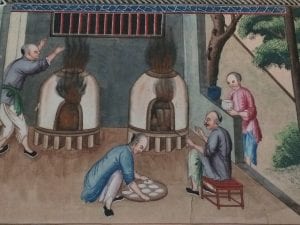Finding Similarities
By Alexandra Rosenberg, WPAMC Class of 2019
On Saturday, the second-to-last day of our Northern Trip, the WPAMC Class of 2019 travelled to Boston’s North Shore. Once there, we visited Beauport, the Sleeper-McCann House. Beauport was originally the summer home of Henry Davis Sleeper, one of America’s first prominent interior designers. As the first site visit of the day, this house set the tone for the day. For me, not only was this house an incredible study in interior design and material culture, but was a fantastic comparison to Winterthur and Henry Francis du Pont’s idea of collecting and design.

The façade and landscape of Beauport, the Sleeper-McCann House. Image by the author.
Like Winterthur’s own H.F. du Pont, Henry Sleeper utilized architectural salvage to construct and decorate the 56 thematic rooms of Beauport. These beautiful historic interiors were meant to serve as a beautiful backdrop to impress guests to Sleeper’s home. The rooms, just like the ones at Winterthur, also served as personal showrooms and evidence of Sleeper’s deep understanding and appreciation for early American material culture, trade networks, and design. One noticeable difference between the design styles of du Pont and Sleeper was du Pont’s adherence to his idea of historical accuracy when designing Winterthur’s rooms and Sleeper’s tendency to organize his rooms thematically around historic and/or literary figures. Despite this difference in design choice, some rooms at Beauport and Winterthur were incredibly similar.

Winterthur’s Chinese Parlor at Yuletide. The soft green hues of the wallpaper match well with the Yuletide tour decorations of a Christmas tree and baskets of red, green, blue and pink wrapped presents. Image courtesy of Winterthur Museum.
The China Trade Room at Beauport struck me as being reminiscent of the Chinese Parlor at Winterthur. The most noticeable connection was the elaborate hand-painted Chinese export wallpaper. While all of the wallpaper at Beauport was positively stunning, this wallpaper quickly became my favorite. Although the wallpapers at both museums have a similar color palette of soft shades of greens, blues and other contrasting colors, the scenes they depict are very different in content. Winterthur’s wallpaper illustrates an idealized scene of village life in China. Beauport’s wallpaper, however, focuses on the production of Chinese ceramics. Essentially, this wallpaper is a piece of material culture that sheds light on another form of material culture and craftsmanship: the production of porcelain. H.F. du Pont and Henry Davis Sleeper were in correspondence with each other, making me wonder just how influential (if at all) Sleeper was in inspiring Winterthur’s Chinese Parlor and choice of wallpaper.

The hand-painted Chinese wallpaper at Beauport depicts ceramics production in China. Image courtesy of Beauport/Historic New England, taken by the author.
The wallpaper in Beauport’s China Trade Room epitomizes several of the lessons taught to us throughout our time at Winterthur: 1) material objects are primary sources of knowledge in-and-of-themselves; 2) one should search for information in the most unlikely of places; and 3) never discount one type of material object’s value to help tell the story of another – if you find wallpaper that illustrates ceramics production, then study it and utilize it to its fullest potential.

Detail of the wallpaper in Beauport’s China Trade Room depicting the firing of ceramics in a kiln by four Chinese men. Image courtesy of Beauport/Historic New England, taken by the author.
Overall, our visit to Beauport, the Sleeper-McCann House brought the teachings of Winterthur full circle. In addition to being an interesting case study of comparison between the collecting styles of H.F. du Pont and Henry Davis Sleeper, this site visit reinforced themes from our first-year classes, all the while bolstering my love for Chinese export material culture.

Leave a Reply